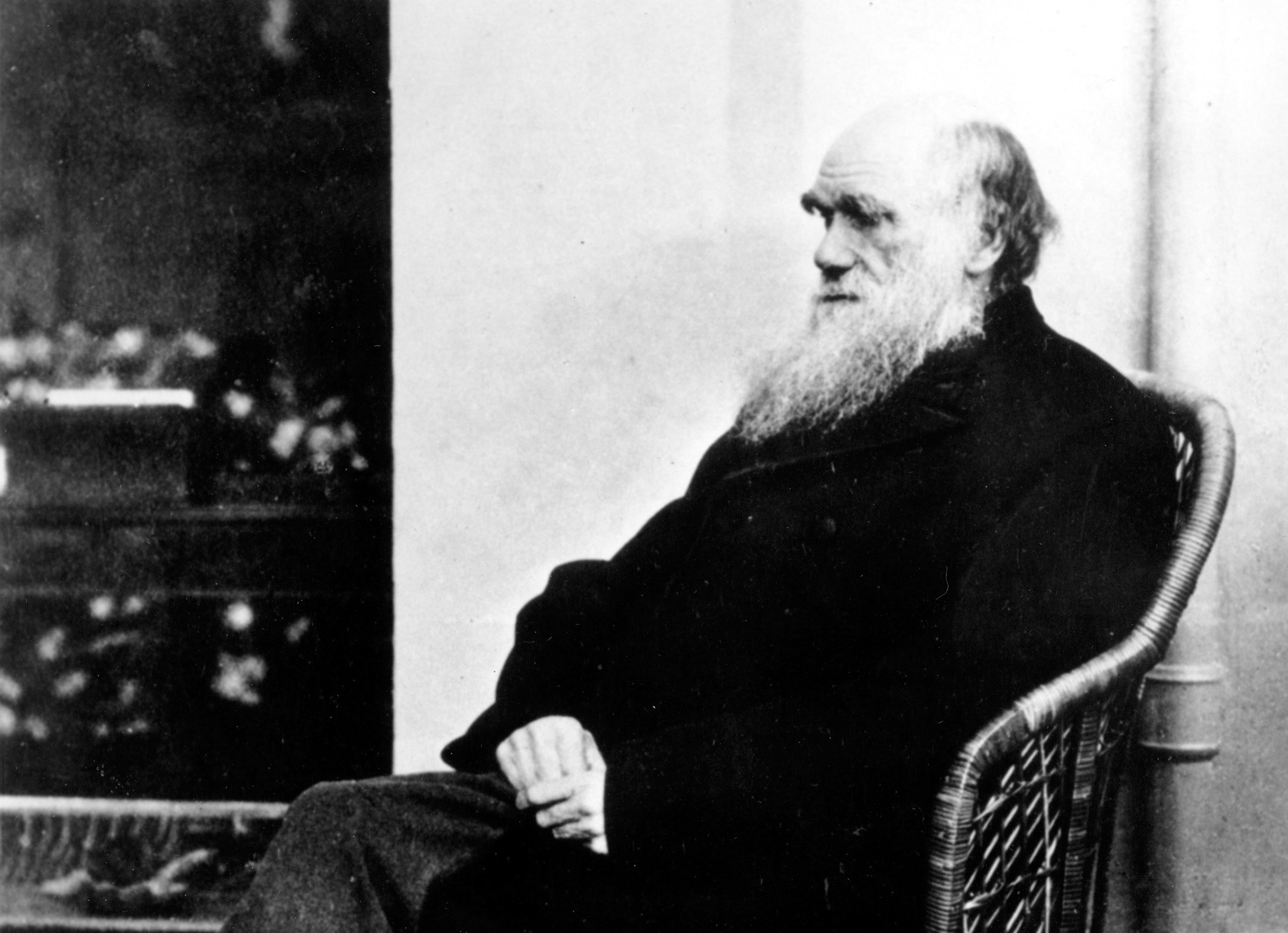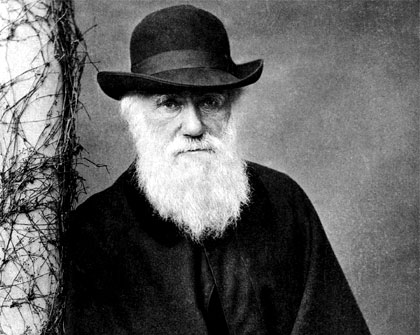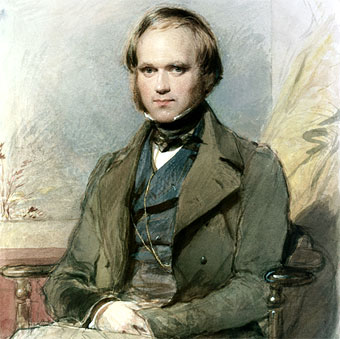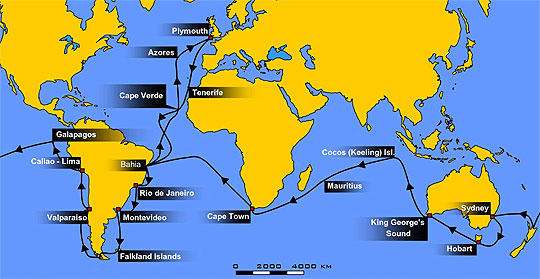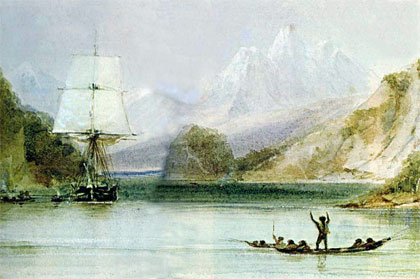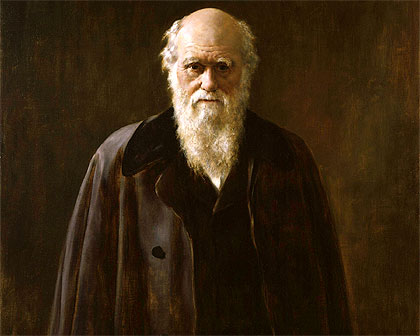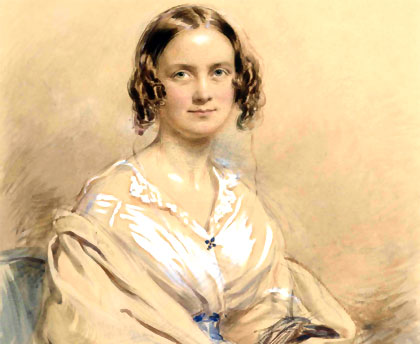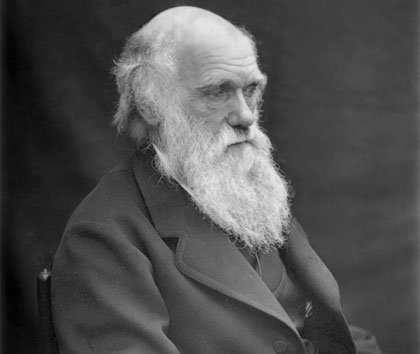The scientific revolution of the Renaissance established new astronomy in which the Earth was no longer the center of creation; his defense earned Galileo an inquisitorial process. When, in the 19th century, the British naturalist Charles Darwin formulated the modern theory of biological evolution on a scientific basis in his work The Origin of Species(1859), also the angriest reactions came from the ecclesiastical estates: the evolutionary model questioned the divine origin of life and man. Once again (and in this lies the historical significance of Darwin’s work), scientific advances undermined firmly held convictions, initiating a change in the mindset of a magnitude comparable to that of the Copernican revolution.
Charles Darwin
Biography
Charles Robert Darwin was born in Sherewsbury on February 12, 1809. He was the second son of Robert Waring Darwin, a local physician of fame, and Susannah Wedgwood, daughter of a celebrated Staffordshire potter, Josiah Wedgwood, promoter of the building. of a canal to unite the region with the coasts and members of the Royal Society.
His paternal grandfather, Erasmus Darwin, was also a well-known physician and important naturalist, author of an extensive poem in heroic couplets that presented an allegory of the Linnaean system of sexual classification of plants, which was a literary success of the time; for the rest, his theories about the inheritance of acquired characters were destined to fall into discredit precisely because of his grandson.
In addition to his brother, five years older than him, Charles had three older sisters and a younger sister. After the death of his mother in 1817, his education was spent in a local school; in his old age, he would remember his experience there as the worst thing that could happen to his intellectual development. Already from childhood, he showed a taste for natural history that he considered innate and, especially, a great fondness for collecting things (shells, stamps, coins or minerals), the kind of passion “that leads one to become a systematic naturalist, an expert, or a miser.”
In October 1825 Darwin entered the University of Edinburgh to study medicine at the decision of his father, whom he always remembered with affection and admiration, and with a respect not without psychoanalytic connotations; Darwin’s hypochondria in adulthood would always combine distrust of physicians with boundless faith in his father’s instinct and methods of treatment.
Young Charles, however, failed to take an interest in the career; In addition to his disgust for surgical operations and the inability of the teaching staff to attract his attention, was added the growing conviction that his father’s inheritance would allow him a comfortable subsistence without the need to exercise a profession such as that of a doctor. So, after two years, his father, determined to prevent him from becoming an idle family son, proposed an ecclesiastical career to him. After resolving his own scruples about his faith, Darwin gladly accepted the idea of becoming a country clergyman and, in early 1828, after refreshing his classical training, he entered Christ’s College, Cambridge.
At Cambridge, as before in Edinburgh and at school, Darwin wasted time studying, often neglected to satisfy his passion for hunting and horse riding, activities that occasionally culminated in dinners with friends. of which Darwin preserved a memory (possibly exaggerated) as of authentic revelry. However, his indolence was tempered by the acquisition of two tastes for painting and music, of which he himself was later surprised, given his absolute lack of musical ear and his inability to draw (an “irremediable evil” that, together with his practical unfamiliarity with dissection, represented a disadvantage for his later work).
Charles Darwin (portrait of George Richmond, 1840)
More than from the academic studies he was forced to undertake, Darwin benefited at Cambridge from his voluntary attendance at the classes of the botanist and entomologist John Henslow, whose friendship brought him “an inestimable benefit” and who was directly involved in two events that determined his future: the expedition to Wales and, above all, the voyage of the Beagle. At the end of his studies in April 1831, the Reverend Henslow persuaded him to delve into geology, a subject for which his classes at Edinburgh had made him a real dislike, and introduced him to Adam Sedgwick, founder of the Cambrian system, who began precisely his studies on it in an expedition to North Wales carried out in April of that same year in the company of Darwin (thirty years later,
But the decisive importance of the figure of the reverend in Darwin’s life is measured above all by the fact that it was Henslow who gave Darwin the opportunity to embark as a naturalist with Captain Robert Fitzroy and accompany him on his proposed journey. perform aboard the Beagle around the world. At first his father opposed the project, stating that he would only change his mind if “someone with common sense” was able to consider the trip advisable.
That someone was his uncle (and future father-in-law) Josiah Wedgwood, who interceded in favor of his young nephew participating in the expedition; Meanwhile, the purpose of traveling had been consolidated in Darwin for months before, when reading the works of the German naturalist Alejandro Humboldt aroused in him an immediate desire to visit Tenerife and he began to learn Spanish and inquire about ticket prices.
The Beagle expedition
On December 27, 1831, the Beagle set sail from Davenport with Darwin on board, ready to begin what he called his “second life” after two months of the discouraging wait at Plymouth, while the ship was repaired from the damage caused on its previous voyage. , and after the gale frustrated two attempts to start. During this time, Darwin experienced “palpitations and pains in the heart” of more than likely nervous origin, as perhaps his frequent prostrations would later be. Without knowing it, Darwin had risked being rejected by Robert FitzroySince the captain, a convinced follower of the physiognomic theories of the Swiss priest Johann Caspar Lavater, initially believed that the naturalist’s nose did not reveal enough energy and determination for the undertaking.
The objective of the expedition led by Captain Fitzroy was to complete the topographic study of the territories of Patagonia and Tierra del Fuego, the layout of the coasts of Chile, Peru and some Pacific islands and the realization of a chain of chronometric measurements around the world. The journey, which lasted almost five years, took Darwin along the coasts of South America, then returned during the last year visiting the Galapagos Islands, Tahiti, New Zealand, Australia, Mauritius and South Africa.
The Voyage of the Beagle
During this period, Darwin’s mood underwent a profound transformation. The ancient passion for hunting survived the first two years with all its force, and it was he himself who was in charge of shooting at the birds and animals that began to swell his collections; Little by little, however, this task was entrusted to his servant as his attention became more and more absorbed by the scientific aspects of his activity.
The study of geology was, in the beginning, the factor that most contributed to making the trip the true formation of Darwin as a researcher since with it the need to reason inexcusably came into play. Darwin took with him the first volume of the Principles of Geology by Charles Lyell, author of the so-called theory of current causes and who was to be his collaborator in the exposition of evolutionism; from the recognition of the first geological terrains that he visited (the island of Santiago, in Cape Verde), Darwin was convinced of the superiority of the approach advocated by Lyell.
In Santiago, he had for the first time the idea that the white rocks he was observing had been produced by molten lava from ancient volcanic eruptions, which, when slipping to the bottom of the sea, would have dragged crushed shells and corals giving them rocky consistency. Towards the end of the voyage, Darwin learned that Adam Sedgwick had expressed to his father the opinion that the young man would become an important scientist; the correct prognosis was the result of the reading by Reverend Henslow, before the Philosophical Society of Cambridge, of some of the letters sent by Darwin.
The Beagle in Tierra del Fuego
Among the scientific achievements obtained by Darwin during the trip, the first to see the light (1842) would be the theory about the formation of coral reefs due to its growth on the edges and on top of sinking islands. slowly. Along with this hypothesis and the establishment of the geological structure of some islands such as Santa Elena, it is necessary to highlight the discovery of the existence of a certain similarity between the fauna and flora of the Galapagos Islands with those of South America, as well as of differences between the specimens of the same animal or plant collected in the different islands, which made him suspect that the theory of the stability of the species could be questioned. It was the theoretical elaboration of these observations that, years later, resulted in his statement of the evolutionary theses.
The fruits of a journey
Darwin returned to England on October 2, 1836; the change experienced in those years must have been so remarkable that his father, “the keenest observer ever seen, naturally skeptical and far from believing in phrenology,” ruled upon seeing him again that the shape of his head it had completely changed. His health had also deteriorated; towards the end of the voyage he became dizzy more easily than at the beginning, and in the fall of 1834 he had been ill for a month. It has been speculated that, in March 1835, he contracted a latent infection called Chagas disease as a result of an insect bite.
In any case, from his arrival until the beginning of 1839, Darwin lived through the most active months of his life, despite the loss of time that occasionally felt unwell. He worked on the writing of his travel diary (published in 1839) and on the elaboration of two texts that presented his geological and zoological observations. Installed in London from March 1837, he dedicated himself to “doing a little society”, acting as honorary secretary of the Geological Society and making contact with Charles Lyell.
Charles Darwin (detail of a portrait of John Collier, 1881)
In July of that year, he began to write his first notebook on his new views on the ‘transmutation of species’, which were imposed on him as he reflected on his own observations on classification, affinities and instincts. of the animals, and also as a result of an exhaustive study of how much information he was able to collect regarding the transformations experienced by species of plants and domestic animals due to the intervention of breeders and horticulturists.
His research, carried out on the basis of “authentic Baconian principles,” soon convinced him that selection was the key to human success in obtaining useful improvements in plant and animal races. The possibility that the same selection will act on living organisms in a natural state was made clear when in October 1838 read “as a hobby” the An Essay on the Principle of Population by Thomas Malthus.
Disposed of as he was, from his long observations on the habits of animals and plants, to perceive the universal presence of the struggle for existence, it instantly occurred to him that, under these circumstances, favorable variations would tend to be preserved, while unfavorable ones would disappear, with the result of the formation of new species. Darwin estimated that, “at last, he had gotten a theory to work with”; however, concerned to avoid prejudice, he decided to abstain for a time from “writing even the most succinct sketch of it.” In June 1842 he allowed himself the private pleasure of a very brief summary (thirty-five pages written in pencil), which he expanded to two hundred and thirty pages in the summer of 1844.
Darwin had married his cousin Emma Wedgwood on January 29, 1839. They resided in London until September 1842, when the family settled in Down, in the county of Kent, seeking a way of life better suited to the frequent periods of illness which, after their return from their journey, constantly afflicted them. Darwin. For the rest, the London years were, as far as social life is concerned, the prelude to an almost total retreat in Down, where he lived to the end of his days. On December 27, 1839, the first child of the marriage was born, and Darwin began with him a series of observations, which lasted over the years, on the expression of emotions in man and animals. He had ten children, six boys and four girls, born between 1839 and 1856,
Emma Wedgwood
During the first years of his stay at Down, Darwin completed the writing of his works on geological subjects and also took care of a new edition of his travel diary, which had originally appeared as part of the work published by Fitzroy on his expeditions; In his autobiographical notes in 1876 (revealingly titled Recollections of the Development of my Mind and Character ), Darwin acknowledged that “the success of this my first literary offspring always inflames my vanity more than any other of my books.”
From 1846 to 1854, Darwin was busy writing his monographs on cirripods, in which he had been interested during his stay on the coasts of Chile when he found specimens of a type that raised classification problems. Those years of work served to turn him into a true naturalist according to the demands of his time, adding to the practical learning acquired during the trip the theoretical training necessary to tackle the problem of the relationships between natural history and taxonomy. In addition, his studies on barnacles gave him a solid reputation among specialists, being awarded in November 1853 by the Royal Society, of which Darwin had been a member since 1839.
The theory of evolution
In early 1856, Charles Lyell advised Darwin to work on the full development of his ideas about the evolution of species. Darwin then undertook the writing of a work which, although conceived on a scale three or four times greater than that of the actual published text, represented, in his opinion, a mere summary of the material collected on the matter.
But when he was halfway through work, his plans were derailed by an event that precipitated events: in the summer of 1858 he received a manuscript containing a short but explicit exposition of a theory of evolution by natural selection, which it exactly matched his own views. The text, sent from the island of Ternate, in the Moluccas, was the work of Alfred Russel Wallace, a naturalist who had been in the Malay archipelago since 1854 and who had already sent Darwin an article on the appearance of new species in 1856 with the one who felt widely identified.
In his new job, Wallace spoke, like Darwin, of a “struggle for existence,” an idea that, curiously, had also been inspired by reading Malthus. Darwin put Lyell in the background of the matter and communicated his hesitations about how to proceed regarding the publication of his own theories, going so far as to state his intention to destroy his own writings rather than appear as a usurper of Wallace’s rights to priority. .
The incident was resolved in a Solomonic way thanks to the intervention of Lyell and the botanist Joseph Dalton Hooker, future director of the Kew Gardens created by his father and one of the main defenders of Darwin’s evolutionary theories, with whom he became close friends from 1843. On the advice of both, Darwin summarized his manuscript, which was presented by Lyell and Hooker to the Linnean Society on July 1, 1858, along with Wallace’s work and with an extract from a letter sent by Darwin on 5 September 1857 to the American botanist Asa Gray, which contained an outline of his theory.
Alfred Wallace never questioned the correctness of the procedure; later, in 1887, he expressed his satisfaction with the way things had developed, arguing that he did not possess’ the love of work, experiment, and detail so preeminent in Darwin, without which anything I could have writing would never have convinced anyone.
The origin of species
After the episode, Darwin was forced to put aside his hesitations as far as the publicity of his ideas was concerned, and tackled the task of reducing the scale of the work at hand in order to send it to the press as soon as possible; In “thirteen months and ten days of hard work,” the book On the Origin of Species through Natural Selection, or the Preservation of Favored Races in the Struggle for Life, was finally written, a long title that is almost the enunciation of his thesis and that is usually abbreviated as The Origin of Species. The first 1,250 copies were sold on the same day they appeared, November 24, 1859.
The theological implications of the work, which attributed to natural selection powers hitherto reserved to divinity, caused a fierce opposition to immediately begin to form, led by paleontologist Richard Owen, who twenty years earlier had enthusiastically welcomed the collections. of fossils brought by Darwin from his trip.
In a memorable session of the British Association for the Advancement of Science in Oxford on June 30, 1860, Bishop Samuel Wilberforce, as the spokesman for Owen’s party, ridiculed evolutionary theses with brilliant eloquence, provoking a forceful replica by the zoologist Thomas Henry Huxley, who was the main defender before the religious opposition of Darwin’s theses, earning the nickname of his bulldog. To Wilberforce’s question as to whether Huxley would have been indifferent to know that his grandfather had been a monkey, the immediate response was, according to Lyell’s testimony: “He would be in the same situation as his lordship.”
Darwin in an image taken around 1874
Darwin stayed away from direct intervention in public controversy until 1871, when his work The Origin of Man and Selection in Relation to Sex was published, where he presented his arguments in favor of the thesis that man had appeared on Earth. by exclusively natural means. Three years earlier his study on the variation in animals and plants by the effects of artificial selection had appeared, in which he tried to formulate a theory about the origin of life in general (“pangenesis”), which turned out to be the poorest. of his contributions to biology.
In 1872, with The Expression of the Emotions in Man and Animals, a seminal work in what would later become the modern study of behavior, Darwin put an end to his preoccupations with theoretical problems and devoted the last ten years of his life to various investigations in the field of botany. At the end of 1881 he began to suffer from serious heart problems and died as a result of a heart attack on April 19, 1882.




